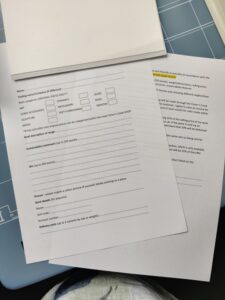It is super exciting to be offered any creative opportunity, regardless of where you are in your artistic journey, but you really need to consider it calmly, look closely at what exactly is being offered and then ensure that you protect yourself, your artwork and your rights as an artist. For this reason it is worth making an artist contract for peace of mind.
So, what is an artist contract? Well, it is a legally binding agreement which outlines the terms and conditions of your relationship with a gallery, a client or, if you are collaborating, a fellow artist or artists. By creating and using an artist contract you safeguard your intellectual property, or your vision where this applies, and it lets people you are dealing with know that you are a professional and you need to be taken seriously. By creating a contract you protect your work and determine clear boundaries with details of your expectations and, if necessary, compensation terms for you and your clients, all of which help prevent misunderstandings and let everyone know exactly where they stand from the beginning. There is nothing worse than falling out with someone because things were not made clear right from the start. 
Commissions are the obvious place to have a contract as you will likely be the driving force behind any agreements, so it is essential you have one in place. Any collaboration with other artists is also another essential occasion for a contract. If you license your artwork you will need to have an agreement in place with the company involved in the licencing. They will no doubt have a contract too, so it may be that you need to negotiate terms so that what you both want is more in alignment. Exhibiting with a gallery or at an art show provides another situation where a contract is essential.
I should mention that recently I entered into a contract with a gallery who then decided to break the terms of said contract. I am still undecided about pursuing this further but I have time and, frankly, revenge is a dish best served cold. If you get involved in an activity, particularly where there is an exchange for cash, then a contract needs to be in place and this could also include giving a talk, a demo, doing some freelance work etc., etc.
This can all feel very daunting but fear not, we can figure this out. Firstly think about how you work and what you expect back from the person(s) you are supplying the work to. Think in terms of how long it will take to compete this work, how much you want to be paid for it, whether there is an opportunity for stage payments, what you are comfortable with in terms of who has ownership and/or copyright of your work and how your will work be used once completed.

You will need to be aware of local laws which will vary from country to country and if in doubt it is always best to seek good legal advice. I must point out here that I am not legally qualified so you should always seek proper advice, rather than act on my observations or opinions. However, my advice is make yourself a check list so that you know what you need to include in your contracts.
To start with you need a document which has your name and contact details at the top and also has the client’s name and details listed. You then need to have a section showing a description of the work, including any details pertinent to the work you are making e.g. colours, size, finishes, completion date and check dates along the way if you are working at a commission. It is then wise to list the amount you expect to be paid, when you expect to be paid and a date each payment (where appropriate) is due.
A terms and conditions section should include anything specially agreed between you and the client, including when you will receive your payment. This will differ between a commission client and a gallery.
It is really important to decide how you want your work used and who owns the intellectual property and who has rights to use it.
Normally, an artist will retain the intellectual property of their work but you can of course sell the rights. If you retain the rights, you can dictate the use of your work, as in do you agree to it being reproduced are you happy for it to be exhibited or loaned by someone else? Only you can decide how you want this to work for you.
Although we always like to think everything will turn out well, the reality is very different so you do need to have a termination clause. This will protect both you and the client. You need to decide terms if an agreement is going to be broken by either party. It just lets everyone know where they stand.
Lastly you both need to sign the contract and have a copy of it for both of you. This would need to be agreed and signed before you start working on the piece.
If you are finding this all a bit daunting you can find various templates on the internet which set out everything so that your contract looks professional. Be prepared to negotiate on any contract. You can of course stick to your position, but flexibility makes for a better working environment.
Once everything is agreed and signed off, make sure you file your contract away safely. I keep a photocopy online, I have a digital copy on file which I record by client and I also have a paper copy which I put in a see-through plastic wallet which stays in the file until the contract is complete. Into that file I add all sorts of other relevant information and stage photos of the work, much of which I pass on to the client as part of the process.
I don’t tell the client I am going to give them stage photos, although I do send some as I am working and as per what we have agreed to in the contract, but I do take lots of photos and write messages on the canvas before I start a project, making it very personal to them. I think that it just become a nice addition to the project for them and it is no trouble to go the extra mile, is it?
NB Just for the record, I do not get paid to endorse any of the brands I have mentioned above.
If you have enjoyed reading this post, please like and follow me and please share it with people who you think might be interested. I am always on the lookout for new artists to feature as I know how much everyone enjoys reading about other artists. Also, if you think there is a subject you would like to know more about and would like me to write about, I will be happy to consider it. Sharing, liking and following my blogs increases the number of people the algorithm shows the blogs to, so please share. Thank you in advance for supporting me this way.
